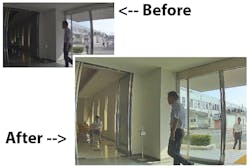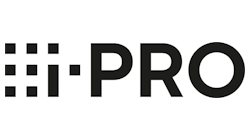For most integrators, there is one factor in managing a video surveillance system that is almost always a challenge: lighting. Whether indoor or outdoor, day or night, lighting issues — both natural and artificial — create problems capturing usable security footage and images. However, recent advances in visibility enhancement technologies have made it possible for security professionals to overcome issues associated with challenging lighting conditions to produce crisp, clear images like never before.
Over the past decade, the security industry has made significant developments in video surveillance technologies, most notably the transition from analog to IP systems. Whereas older analog devices were limited in their ability to compensate for varying ranges of light, noise and image distortion, newer IP-based devices feature a mix of software and hardware technologies including mechanisms for dynamic frame and contrast filtering that provide for clear identification of images in both light and dark areas and in high contrast areas common in video surveillance deployments.
HD video imagery is perhaps the most popular technology that has emerged from this shift. Security cameras that feature HD technology are able to significantly enhance details otherwise obscured by glare or noise, providing a much clearer picture that offers improved performance under challenging lighting conditions or when recording rapidly moving objects. For example, by combining Full HD 1080p or HD 720p resolution with a 60fps high frame rate, IP cameras can successfully capture rapidly moving objects such as slight-of-hand activities in a casino, recognize the characters of a vehicle’s license plate on a dark or foggy road, and even remove environmental noise such as rain to capture better images. And yet, even as HD video paves the way for 4K resolution, there remain many factors dealing with environmental challenges such as lighting are certainly the most troublesome.
Visibility enhancement software is the answer to this problem. Engineered to reduce the challenges of both inside and outside installations, cameras offering visibility enhancement software compensate for varying ranges of light, noise and image distortion, allowing for much improved focus and detection of faces, patterns and other minute details no matter the weather. Offering clear identification of images in both light and dark areas in high-contrast zones, enhancement software technology is making it possible for security professionals to advance their security solutions well beyond the limitations of current HD imagery.
Seeing in the Dark
Nighttime recording is one of the greatest challenges security integrators face, as dynamic range, discoloration and noise caused by reduced lighting and moving objects are the source of endless headaches. The latest IP cameras, however, can produce detailed video images in low light at less than .01 lux illumination — using advanced processors to capture clear images of human faces and clothing without the overexposure common in standard IR models.
Reduced high-light visibility is yet another problem that emerges during nighttime surveillance. For example, when recording an outside zone, it is near impossible to avoid the glare, noise and overexposure generated by headlights, which is affected by factors such as the color and lux of the lights, nearby light sources and reduced visibility overall.
These contrast issues result from the way wide dynamic range is processed and are not easily overcome without tradeoffs. In many cases, installing two cameras will enable users to minimize these problems with technologies such as high light compensation (HLC). These devices are specifically programmed to recognize instances where video data is being overpowered by excessive light and can compensate for it in order to clearly identify objects. For integrators looking to advance their systems even further, cameras offering built-in infrared (IR) LED mechanisms should also be deployed, as they are designed to illuminate full view evenly without reflection on the dome cover in order to minimize the image distortion.
Day to Night and Back Again
When it comes to changing lighting conditions, many of today’s security cameras offer autofocus mechanisms that enable them to adjust to differences in depth; however, as many of the standard devices change modes between day and night, the imagery they capture briefly moves out of focus with or without the IR-cut filter. To overcome this issue, the latest cameras incorporate visibility enhancement options for auto back Focus (ABF) processes that adjust image sensor positions automatically to maintain accurate focus. Variable exposure and shutter speed controls can also be adjusted to capture both bright and dark areas more clearly. By adopting cameras that deliver ABF features, security systems operators can not only reduce maintenance but also streamline field installation, ensuring the maximum return on investment.
With visibility enhancement, issues related to dynamic range can also be reduced. With the rapid market penetration of HD cameras that can capture larger areas than traditional cameras, wide-angle-view lenses are extremely popular but often produce images with clear barrel distortion. The distorted images can affect visibility and the recognition rate and accuracy of facial recognition and similar technologies. Similarly, video surveillance requires a wide depth of field in order to capture objects clearly both near and far, but varied lighting conditions can create distortion of this distance over time. Lens distortion compensation (LDC) and depth of field (DOF) correction technologies are critical features of any new video surveillance camera, as they ensure the imagery is translated correctly, without being skewed by lens design or device placement.
Another concern for many security professionals is discoloration in poor lighting conditions. As any security integrator knows, the color of recorded images often becomes altered as lighting conditions change. For example, a camera may record crystal clear imagery during the day only to fail later as the sun sets or shade from trees begins to shift. This happens because built-in infrared (IR) cut filters are sometimes removed to increase light sensitivity, and while this process is used to help cameras capture a greater area, it typically has a negative effect on the clarity of details that may be important for end-users. The latest cameras now offer visibility enhancement mechanisms such as Super Chroma Compensation that are specifically designed to recover the original color of objects by digital image processing without sacrificing the integrity of new video data.
Noise and Environmental Factors
As with discoloration, environmental noise creates major headaches for security integrators and is worsened by low-quality video signals in poor lighting conditions. Increased noise occurs as a device attempts to process video signals in poor light conditions, causing grainy video that can make identifying objects near impossible. With the multi-process noise reduction (MNR) and digital noise reduction (DNR) features offered by newer cameras, security operators can program their systems to become more sensitive to differences in light and texture, adjusting the image to deliver clear color images without low-light visual noise.
Environmental factors such as humidity, fog and rain can also create major issues in obtaining usable video from outdoor surveillance cameras. Fortunately, this issue is being addressed with new visibility enhancement mechanisms. Newer cameras even feature built-in electric anti-humidity units that prevent condensation on the cover and lens, while digital processors can be adapted to filter out noise from conditions such as fog, haze, smoke, smog, dust and sandstorms. As a result, outdoor cameras can still deliver outstanding clarity and high resolution without interference.
Image degradation resulting from obscure moving objects such as rain or snow can also be reduced. Leveraging cameras that offer GPU accelerated computing and high-speed image processing algorithms, security integrators can ensure their systems deliver the power required to capture these details and perform in a range of challenging environments.
Greg Peratt is Senior Director of the Panasonic Video Solutions Integration Team. To request more information about Panasonic, please visit www.securityinfowatch.com/10214586.



